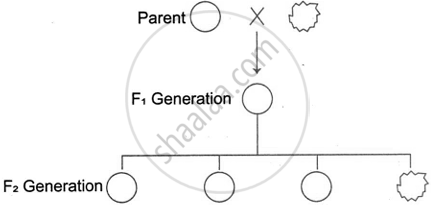Advertisements
Advertisements
प्रश्न
Explain Mendel’s monohybrid progeny with the help of any one cross.
उत्तर
- In this experiment, Mendel brought about the cross between two pea plants with only one pair of contrasting characters. This type of cross is called a monohybrid cross.
- Tall pea plants and dwarf pea plant were used in this cross. Hence, this is parent generation (P1). Mendel referred to the tall and dwarf plants as dominant and recessive respectively. The tall plant was referred to as dominant because all the plants in the next generation were tall.
- The dwarf plant was referred to as recessive because this characteristic did not appear in next generation at all.
- Though all the plants in F1 generation were tall, they contained the factor responsible for dwarfness. i.e. though the phenotype of F1 plants is tall, their genotype is mixed.
- Genotype of F1 tall plants is Tt and it produces two types of gametes, T and t. Thus, based on this, we can say that in case of tall plants of F1 and P1 generations, though they show similar phenotype, their genotypes are different. Mendel further continued this experiment and brought about self-fertilization in F1 plants from which a second filial (F2) generation was produced.
- According to the data collected by Mendel, out of 929 pea plants, 705 were tall and 224 were short. Thus, the phenotypic ratio of these plants is 3(tall):1(dwarf) and genotypic ratio is 1(TT):2(Tt):1(tt).
- Thus, it can be inferred that in the F2 generation, phenotypically there are two types of plants whereas genotypically there are three types. These types are shown in the following table.
F2 Pure dominant TT - tall plants Homozygous F2 Pure recessive (tt) - dwarf plants Homozygous F2 Hybrid plants (Tt) - tall plants Heterozygous
| Mendel’s experiment of the Monohybrid Cross | |||
| Parental Generation P1 | |||
| Phenotype | Tall | Dwarf | |
| Genotype | TT | tt | |
| Gametes | T | t | |
| First Filial Generation F1 | Tt | ||
| (Phenotype: Tall) | |||
| Parental Generation P2 | Selfing in F1 | ||
| Phenotype | Tall | Tall | |
| Genotype | Tt | Tt | |
| Gametes | T t | T t | |
| First Filial Generation F2 | Male gamete/Female gamete | T | T |
| T |
TT Tall |
Tt Tall |
|
| t |
Tt Tall |
tt Dwarf |
|
APPEARS IN
संबंधित प्रश्न
Differentiate between the following -
Homozygous and Heterozygous
A child has blood group O. If the father has blood group A and mother blood group B, work out the genotypes of the parents and the possible genotypes of the other offsprings.
Given below are the F2 – phenotypic ratios of two independently carried monohybrid crosses :
(i) 1 : 2 : 1
(ii) 3 : 1
Mention what does each ratio suggest.
Mention whether the cross is a monohybrid or dihybrid.
What is a monohybrid cross? How did Mendel perform this cross?
A pure tall plant (TT) is crossed with the pure dwarf plant (tt), what would be the F1 and F2 generations? Explain.
Pure-bred tall pea plants are first crossed with pure-bred dwarf pea plants. The pea plants obtained in the F1 generation are then selfed to produce F2 generation of pea plants.
What do the plants of the F1 generation look like?
Pure-bred tall pea plants are first crossed with pure-bred dwarf pea plants. The pea plants obtained in the F1 generation are then selfed to produce F2 generation of pea plants.
What is the ratio of tall plants to dwarf plants in the F2 generation?
Give reasons why acquired characters are not inherited.
A Monohybrid cross is ______
In a monohybrid cross of plants with red and white flowered plants, Mendel got only red-flowered plants. On self-pollinating these F1 plants got both red and white flowered plants in 3:1 ratio. Explain the basis of using RR and rr symbols to represent the genotype of plants of parental generation.
In a plant tallness is dominant over dwarfness and red flower is dominant over white. Starting with the parents work out a dihybrid cross. What is standard dihybrid ratio? Do you think the values would deviate if the two genes in question are interacting with each other?
Pooja has green eyes while her parents and brother have black eyes. Pooja’s husband Ravi has black eyes while his mother has green eyes and father has black eyes.
a. On the basis of the above given information, is the green eye colour a dominant or recessive trait? Justify your answer
b. What is the possible genetic makeup of Pooja’s brother’s eye colour?
c. What is the probability that the offspring of Pooja and Ravi will have green eyes? Also, show the inheritance of eye colour in the offspring with the help of a suitable cross.
OR
c. 50% of the offspring of Pooja’s brother are green eyed. With help of cross show how this is possible.
Assertion (A): In humans, if gene (B) is responsible for black eyes and gene (b) responsible for brown eyes, then the colour of eyes of the progeny having gene combination Bb, bb or BB will be black only.
Reason (R): The black colour of the eyes is a dominant trait.
Given below is a schematic representation of the inheritance of the shape of the seeds of garden peas. Answer the questions that follow:

- Which is the dominant and recessive allele of the trait?
- What does the ratio 3 : 1 in the F2 generation represent?
- State Mendel's Law of Dominance.
